Little known to most, Iran’s northern crescent is home to some of the world’s most pristine temperate rain forests. This area, on the northern side of the Alborz Mountains, includes over 1,000 kilometers of coastline and spans four different provinces. Gilan, sometimes written Guilan, is the most picturesque of these provinces and is easily accessible, from Tehran, Iran’s capital.
For all tips for travel to Rasht and Gilan, read on.
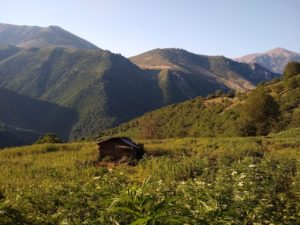
Hiking trails through the Alborz Mountains in Masuleh, Gilan, Northern Iran
Climate & Geography
As you travel north into Gilan, there is an abrupt change in the terrain. The border town of Rudbar welcomes visitors to Gilan with its roadside restaurants and shops selling local produce such as olives, pickles, and pottery. Passing through Rudbar, you cross the Sefid River, a fast-flowing snow-fed stream that flows all the way to the Caspian Sea. Travel 20 kilometers further into Gilan and all signs of aridness disappear, giving way to thick, green forests. Welcome to Gilan!
Visitors can enjoy a unique Gilan experience year round. Many Iranians (especially Tehranis) flock to Gilan for weekends and holidays 12 months a year. The summers are cooler than Central Iran with the mercury hovering around 30 degrees Celsius most days. Winters are cold and the mountains will be snowcapped from December through to March- April. Gilan is much wetter than the majority of Iran, so you can expect rains anytime during the year and long rainy periods are also common.
People & Culture
Both linguistically and ethnically unique, the people of Gilan are renowned for their cuisine, relaxed lifestyle and bossy women. Gilan has two languages – Gilaki and Talashi. Gilaki was traditionally spoken by the low-land people and Talashi is the tongue of the mountain people. Both distinct from one another and Farsi (the official national language) these languages still are spoken by most of Gilan’s population today.
Also check out: Travel Iran by car
The women of Gilan are famous for being hard working, strong matriarchal figures. Dressed in their brightly patterned clothes, women work in the rice fields and as cow-herders, as they have done for centuries. The women also weave beautiful baskets from the sea-grasses of the Caspian coastline which are sold locally and exported nationwide.
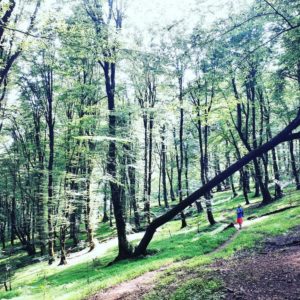
Hike through Gilan’s spectacular temperate rain forests on your trip to Iran!
Top Destinations in Gilan
Rasht
Rasht is the capital city of Gilan with a population of 700,000. Two rivers run through Rasht city and out to the Caspian Sea. Having been occupied by Russians for brief periods in the 18th, 19th and 20th century, Rasht is a melting pot of European, Russian, Soviet and Persian culture. If you travel to Rasht, you can enjoy the many tea houses on the river and the picturesque town square. You can consider using Rasht as a base to explore the Gilan region. You can book Click Rasht hotels online through 1stQuest.
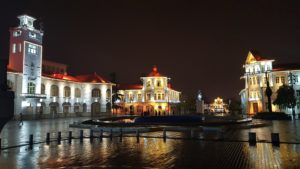
Rasht town square (photo credit: By AlexTrn1991 – https://commons.wikimedia.org/w/index.php?curid=72439758)
Qale Rudkhan
Probably Gilan’s most iconic touristic site, Qale Rudkhan is a must see. Located just outside of the town of Fuman or 50 minutes drive from Rasht, the site is centered around the ruins of the 1,300 year old Rudkhan castle. The castle was built by the local Talashi people during the Sasanian period as a fortress to keep out the invading Arabs. Set in the temperate rain forests of the area, you can easily spend a day here trekking up to the castle and enjoying the river, waterfalls, restaurants and traditional tea houses that surround the site.
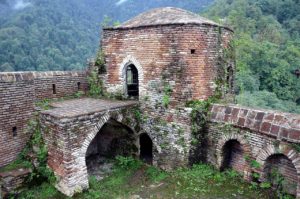
RudKhan Castle in Gilan was built over 1,300 years ago to defend against Arab invasions (photo credit: By Alireza Javaheri, CC BY 3.0, https://commons.wikimedia.org/w/index.php?curid=59092448)
Masuleh
Set high in the mountains about an hour drive inland from Rasht is the idyllic village of Masuleh. The beautifully quaint village and bazaar always prove to enchant visitors with its old-world feel. From here you can hire a guide or take yourself on a hike into the woods.
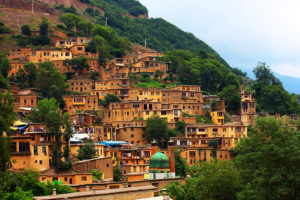
The village of Masuleh demonstrates the unique traditional architecture of Gilan.
Also check out: Exotic villages in Iran
Ramsar
The town of Ramsar is a hidden gem along the Caspian coast, just 1.5 hours from Rasht. The remarkable thing about Ramsar is a unique landscape. At Ramsar, you can travel from sea level to 600m elevation in a 10-minute cable car journey. Picture this. From the shores of the Caspian Sea, take the cable car that passes over orange groves and into the thick forests that lead up to cloudy mountain peaks. Ramsar itself is a cute little town. Attractions include the old casino, tree-lined boulevards, palaces, and hot springs. UNESCO’s 1975 Ramsar Convention on Wetlands was ratified in Ramsar, in a bid to conserve local wetlands as well as wetlands worldwide.
Also check out: Guide to the Best Beaches in Iran
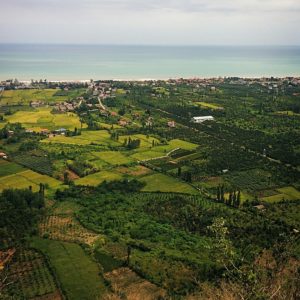
The mountains are so close to the sea at Ramsar Photo credit: Ehsan Doostmohammadi, Wikicommons
Where to stay in Gilan
Moein Hotel, Fuman
Moein is a four-star hotel located on the main road between Fuman and Masuleh. The rooms at Moein are spacious and have great views of the surrounding tea plantations and mountains. Guests can relax in the onsite, perfectly maintained pool and spa complex after a long day of hiking.
Also check out: Iran’s Best Ecolodges
Gileboom Homestay, Chaboksar
Do you want to stay in a treehouse or maybe a traditional style cottage? Through implementing sustainable practices such as rainwater harvesting, greywater reuse and vermicomposting, the owners of this fabulous homestay are on their way to creating a 100% carbon neutral ecolodge. Guests will have the opportunity to participate in the many activities and tours offered at Gileboom Homestay.
Kadus Hotel, Rasht
The best option from Rasht itself is Kadus Hotel in the city center. Built-in 1983 and recently renovated, this five-star hotel’s kitchen style will charm the socks off its guests.
Bam Sabz Hotel, Ramsar
Bam Sabz hotel offers a totally unique experience for visitors. Catch the cable car up to the hotel complex and stay the night in a self-contained log cabin complete with private ensuite, kitchenette, and central heating/air-con. Enjoy the breathtaking panoramic views of the forests and uninterrupted views of the sparkling Caspian Sea.
Villas
The option to stay in a villa (a small, freestanding house) will undoubtedly be offered to visitors to the area as many locals rent out their own home to visitors for a night or two. Although these villas will most likely be equipped with a kitchen and be more spacious than a hotel, beware that you are unlikely to be provided with clean bedding or any towels.
Also chek out: Important Points to Consider Before Booking a Hotel in Iran
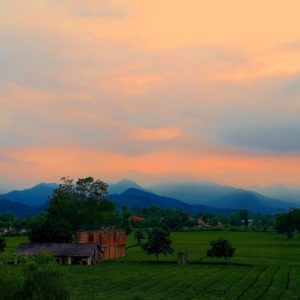
View from the Moein Hotel in Fuman, Gilan, Northern Iran
Eating & Drinking
Foodies are in for a treat! Because of its rich agriculture, Gilan has been recognized for its diverse and unique cuisine by the international community. Rasht, as the capital city of Gilan, has been listed by UNESCO’s Creative Cities Network for its gastronomy. Special dishes include:
- mirza ghasemi – an eggplant, tomato and egg dish served with rice or bread
- kebab torsh – barbecued meat marinated in pomegranate sauce and crushed walnuts, and
- baghali ghatogh – fava bean stew with fennel and eggs served with rice.
Gilan grown tea, olives and oranges are sought out throughout Iran. Oh, and most of Iran’s caviar is from this region too!
Bam Sabz Restaurant, Maklavan
Located between Fuman and Masuleh in the village of Maklavan is this family-run eatery. Generally speaking, food miles in Gilan are very low but here you can eat a three-course meal where all ingredients will be sourced within a 5 mile radius of the restaurant. Local rice, handmade yoghurt and famous Fumani tea are served up here along with several types of kebabs and typically Gilani dishes. Open breakfast, lunch and dinner, what this place lacks in decor it makes up with great prices and homemade food filled with love.
Pedar Teahouse, Fuman
Within the grounds of the Moein Hotel, you will find Pedar Cafe and Restaurant. The traditional style house will entice diners with its cute garden and friendly staff. Come here in the late afternoon for Gilan’s best tea and water pipe.
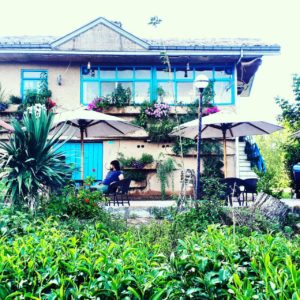
Pedar Teahouse serves fresh tea from the onsite tea plantations, Fuman, Gilan, Northern Iran
Planning your trip
If you have time, spend at least a few days in Gilan. You can stay the first night in Rasht, then head to the Fuman area to check out Qale Rudkhan and Masuleh for two nights, then an additional night or two somewhere close to the Caspian Coast, for example, Ramsar.
All incoming international visitors need an Iranian tourist visa. This can be applied for in advance or obtained on arrival. Pre-arranging your visa reduces your risk of rejection. You can apply for an Iran visa online at 1stQuest.com.
A four-hour drive from Tehran, Gilan is easily accessible by bus or private transfer. Search and book your transportation via 1stQuest.

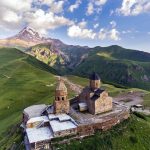


I will definitely put Gilan on my bucket list! Thanks for sharing.
Hello! What about a trip to Gilan in december/january? I know : its cold. But are the natural landscapes in this time also beautiful? I would like to go there in the spring time, but its not possible for me. Thank you! (sorry for my english)
Hi César! I’m so happy to hear you’re planning to pay a visit to my country. Gilan is truly a city best visited during autumn and spring, but like any other place, it has its beauties throughout the year. If you plan on coming in December or January, know that there will be a lot of snow, so bring warm and cozy clothes.
Wow, such a pleasant place, How can I get there?